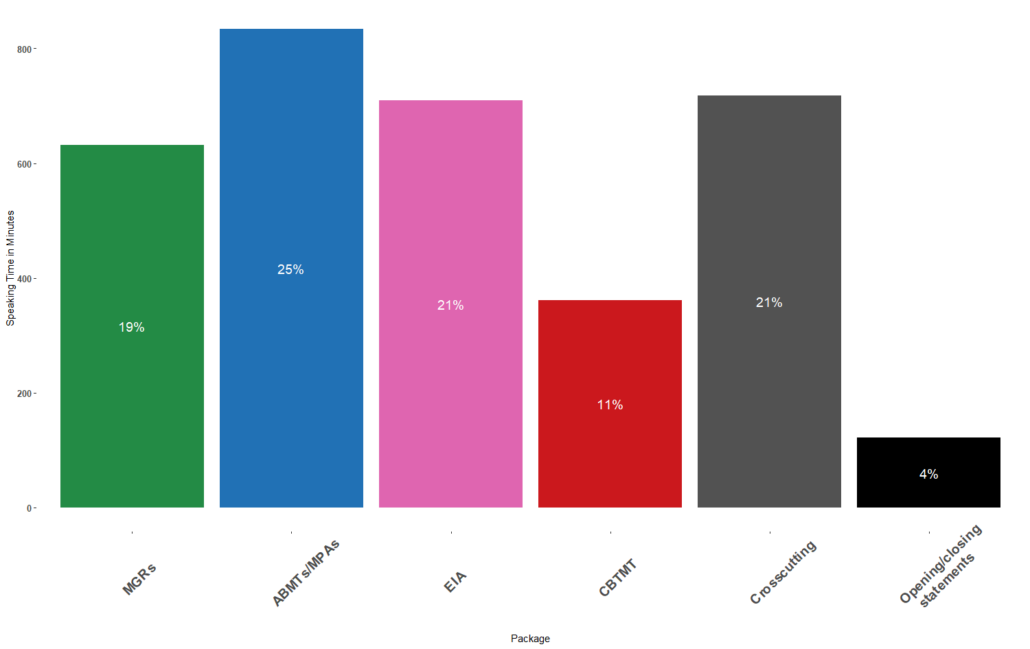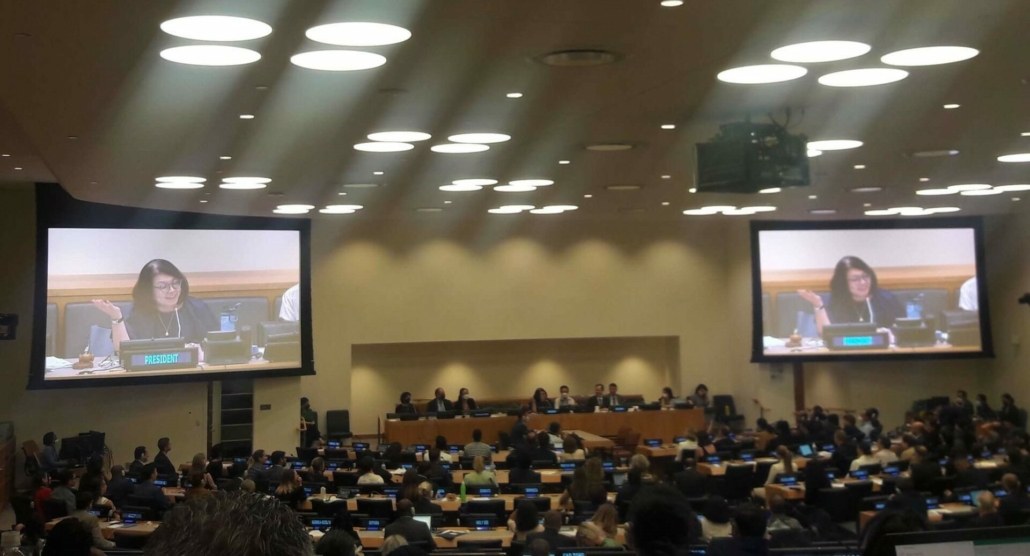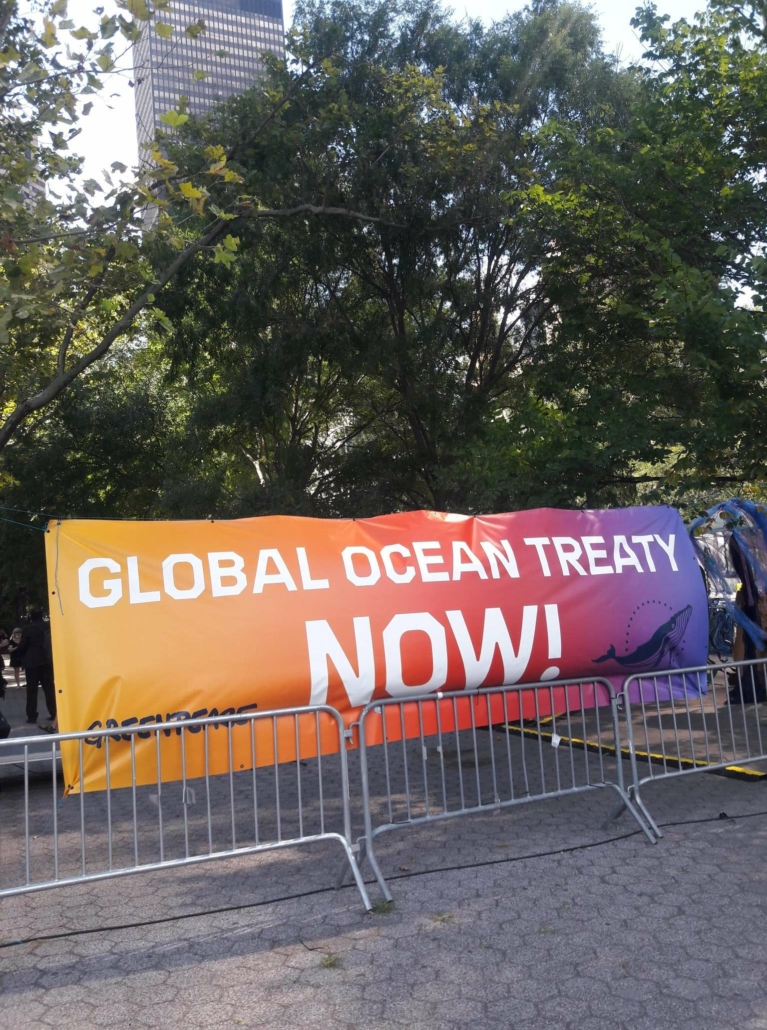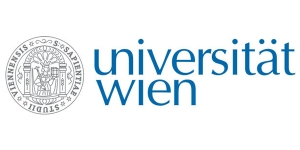Too High Hopes for a High Seas Treaty?
By Ina Tessnow-von Wysocki, Arne Langlet, Klaudija Cremers (IDDRI), Paul Dunshirn, Silvia Ruiz Rodríguez and Alice Vadrot
Negotiations for a legally binding agreement for the conservation and sustainable use of marine biodiversity of areas beyond national jurisdiction (BBNJ) have once more ended without conclusion of an Agreement. The process started in 2004 with the Ad-Hoc Open Ended Working Group and Preparatory Committee meetings and a United Nations General Assembly Resolution gave States the mandate to conclude negotiations by 2020 after four sessions. Due to the Covid-19 pandemic, the fourth conference was postponed and informal discussions were initiated in a virtual format[1], enabling the exchange of views until earlier this year when the mandate was extended for a fifth session. The MARIPOLDATA Team attended the fifth – and supposedly final – conference and documented the key developments in the process. Even though States are now closer to an Agreement than ever before, it will be crucial to address outstanding issues in the inter-sessional period, to reach consensus at the upcoming session.

Source: Unsplash
Participants arrived in New York with great motivation to overcome the many remaining issues within the “package deal”[2] and to reach an agreement on the BBNJ instrument during the fifth Intergovernmental Conference (IGC5). There was hope that the highly ambitious statements made during the UN Ocean Conference 2022 could lead to a successful conclusion of the negotiations this year and introduce much needed legally binding regulations for High Seas governance in order to protect the ocean and use it sustainably, fairly and equitably among all nations. After a slow start into the first week[3], significant progress was made towards the end of week one, which raised hopes of negotiators and non-governmental organisations that the treaty could be completed during IGC 5. Even though States and regional groups showed more flexibility and submitted text proposals prior to and during the 2-week long conference, key issues in all package elements could not be resolved.
IGC5 was characterised by different negotiation formats, including plenary sessions (streamlined on UN Webcast), “informal informals” (open to registered observers) and “closed sessions” (accessible by state negotiators only). The MARIPOLDATA team collected data in both the plenary sessions and informal informals on-site during the in-person meetings and by participating virtually. Our collected data and a preliminary analysis thereof allow us to dive deeper into the dynamics of IGC 5, the discussed package items, and actor constellations.
The following graph portrays the distribution of speaking time that delegates spent negotiating the different package items (Marine Genetic Resources (MGRs), Area-based Management Tools (ABMTs)/ Marine Protected Areas (MPAs) and Capacity Building and the Transfer of Marine Technology (CBTMT)) in these two open negotiation formats, not including the closed sessions.

Graph 1: Total Speaking Time in BBNJ Negotiations IGC5 per topic, Source: Authors
The graph indicates that most negotiation time was spent on ABMTs/MPAs, followed by EIAs and crosscutting themes. MGRs and CBTMT on the other hand, were less discussed in the open formats. This overall distribution of speaking time on the different package elements observed in IGC5 stands in contrast to data from the previous IGC4 (see MARIPOLDATA Blogpost from March 2022), where MGRs & CBTMT were discussed more and negotiation time on AMBTs/MPAs and EIAs was comparatively lower. Our results show the different negotiation dynamics in IGC5: ABMTs/MPAs discussions took ¼ of the total negotiation time, as it was extended into the evenings multiple times in the need for further discussions. In the second week of negotiations, closed sessions were held for all package elements, which was particularly the case for the package elements MGRs and CBTMT – those the least discussed in the plenary and informal informals. Both package elements are deeply interconnected: CBTMT is largely dependent on the outcome of the discussions on the MGRs section as regards how much funding will be available for capacity building efforts. Besides awaiting agreement in the MGRs section, no significant disagreement was observed in the CBTMT part and thus, very little time was devoted to discussing CBTMT in Week 2. The MGRs chapter which may be key to unlocking the CBTMT chapter and which has arguably evolved the most during IGC5, was largely discussed behind closed doors and therefore shows up as the second least discussed item. As can be seen, little time was spent on opening and closing statements (roughly 4%) at this stage of the negotiation process to make time for negotiating text.
Turning Point in the Negotiations: Closer to an Agreement than ever before
Despite falling short of an agreement, delegates emphasised that this fifth session has been the most productive. Progress could be seen in each of the package elements and also on cross-cutting issues, where near consensus was reached on several issues that had been impossible to resolve since the beginning of the negotiations. More flexibility from the side of negotiators, some of whom communicated their “red-lines” for the first time and thereby clarified the room for compromise, as well as creative legal drafting made this huge step towards the finish line possible:
On marine genetic resources (MGRs), States were able to break the deadlock between proponents of monetary vs. non-monetary benefit-sharing. Some common ground was found around the idea of decoupling access and benefit-sharing, so as to allow for monetary benefit-sharing (based on ‘flat fee’ contributions from MGR user countries) without requiring an extensive monitoring system or access barriers to scientific databases. Agreement was found in discussions about the notification mechanism for pre- and post-cruise reports and the uploading of datasets, and substantial progress was made on non-monetary benefit-sharing.
On area-based management tools (ABMTs), including marine protected areas (MPAs), agreement was reached on the preparation and review of proposals, and important parts of the decision-making provision. Moreover, a provision on emergency measures was added, to ensure timely reaction to natural disasters and activities that are (or risk to be) harmful to the marine environment.
On environmental impact assessments (EIAs), the lengthy debates on the inclusion of cumulative impacts and strategic environmental assessments (SEAs) in the text seem to be settled (but without definitions or details) and creative drafting managed to resolve the issue on whether to refer to “planned” or “proposed” activities. General agreement was also on the need for inclusiveness and transparency of EIA reports.
On capacity building and transfer of marine technology (CBTMT), States agreed on the establishment of a CB&TT committee, and monitoring and review provisions to ensure more CBTMT takes place.
On cross-cutting issues, progress was made on compliance, dispute settlement, general principles, and international cooperation. Key definitions were also discussed and general consensus was found on terms to be used, such as ABMTs, MPAs and EIAs, while others were deleted, including SEAs and “activity under state jurisdiction and control”. Moreover, negotiators managed to streamline the text significantly.

Plenary Room at the United Nations Headquarters, New York. Source: Author
Swirls of disagreement – why there was still no consensus
While major steps towards compromise were taken, key issues are still outstanding, some of which date back until the beginnings of the discussions and can have significant implications for the implementation of the new agreement. It will be important to consider these points for reflection and exchange in this intersessional period until the next conference to find compromises during the final session.
Regarding MGRs, the envisioned decoupling of access and benefit-sharing requires further deliberation on several aspects. If negotiators were to pursue this path, they need to agree on how high ‘flat fee’ contributions should be. Another issue that remained underspecified in the latest draft version is in how far the definition of MGRs or their utilisation should include digital sequence data, where many delegates referred to the (still) ongoing negotiations to define digital sequence information (DSI) in the context of the Convention on Biological Diversity (CBD) negotiations for a new Global Biodiversity Framework. How the potential outcomes of the CBD discussions relate to the working of the Access and Benefit Sharing (ABS) mechanism in the BBNJ agreement remain unclear. For the BBNJ negotiations, the idea of the decoupled approach sets forth that access to genetic sequence databases would not be restricted as part of non-monetary benefit sharing, and that monetary benefit sharing occurs independently of the utilisation of data. Having this in mind may motivate negotiators to become more flexible on the exact wording of the MGR definition. This discussion also relates to the question of intellectual property rights, where some States stick to their position that monetary benefits should include patent royalties. Substantial parts of the CBTMT chapter depend on the outcome of these discussions, which should be continued as soon as possible.
Regarding ABMTs/MPAs, initial discussions about conflicting terminologies that date back to previous international negotiations, such as the divide between the use of “precautionary principle” and “precautionary approach”, as well as the problematic discussion on “not undermining” came up again shortly before the treaty was supposed to be finalised and adopted. Several “closed sessions” that could only be attended by State delegates and were not accessible to observers, proved to be helpful to advance on reaching consensus and exploring solutions to settle main disagreements. Another unresolved question includes the possibility for “opt-outs” in the ABMTs/MPAs section, which would allow State Parties to decide on a case-by-case basis whether or not they commit to comply with the regulations of a certain ABMT or MPA established under the BBNJ instrument. While this may lead to a higher number of signatories to the treaty, it significantly puts at jeopardy the level of ambition and hence the effectiveness of the agreement in protecting the marine environment.
In the EIA section, significant progressive streamlining and “cleaning of the text” was done on the final day of the negotiations, which again raised the hope that States would be able to reach a compromise to get the final agreed treaty text. Unfortunately, however, many States needed to reserve their positions and “check with capital”, which could be understandable considering the time differences of various countries, but could also have been a negotiation strategy to delay progress.
Moreover, the two very contrasting views on decision-making in the EIA process did not resolve into a compromise. Developing countries tended to prefer a more internationalised process with decision-making not being a sole competency of the state that proposes the activity, whereas developed states held a strong position for a state-led EIA process. The same divide occurred between proponents of an impacts-based and location/activity-based approach, whereby the former emphasises the need to take into account the impacts on ABNJ, whereas the latter focuses solely on activities undertaken in ABNJ. Proposals included voluntary impacts-based approaches and additional references to the United Nations Convention on the Law of the Sea (UNCLOS), which already contains obligations relevant to EIAs (UNCLOS Art. 192; 194.2).
| UNCLOS Art 192: States have the obligation to protect and preserve the marine environment.
UNCLOS Art 194.2: States shall take all measures necessary to ensure that activities under their jurisdiction or control are so conducted as not to cause damage by pollution to other States and their environment, and that pollution arising from incidents or activities under their jurisdiction or control does not spread beyond the areas where they exercise sovereign rights in accordance with this Convention. |
The idea for a call-in mechanism, which could be useful to address concerns of EIAs of convenience was discussed to enable States to “call in” in cases where they challenge a State’s decision to authorise activities in ABNJ due to an arguably acceptable level of impact on the marine environment. However, consensus on the practicalities and decision-making in this regard was not reached. The opportunity for BBNJ bodies to provide guidance on EIAs was welcomed, however, States are still divided on whether the EIA section should include legally binding global standards or voluntary guidelines. Finally, but not least importantly, discussions on the threshold for conducting EIAs are still in deadlock over the two proposed thresholds from previous sessions[4].
In CBTMT, the details of the special fund for CBTMT under the BBNJ instrument are directly linked to the outcomes of the MGR chapter and therefore remain unresolved. While most States see the value of establishing a non-exhaustive and open list of types of CBTMT, divergence remains about its placement in the text and the role of the COP in updating it. Some countries want it enshrined in the Treaty for a legally-binding character, others warn about the inflexibility of such a list and prefer to task the COP with the creation of recommendations in this regard. Moreover, States still need to agree if a CBTMT review mechanism is needed or whether this task can be fulfilled by another subsidiary body such as the Clearing-house Mechanism or the Scientific and Technical Body.
Another open question is in relation to the new BBNJ Secretariat. Options are on the table for it to be created new, or attached to an existing body, such as UNDOALOS. To address concerns of overburdening of UNCLOS to take on additional BBNJ issues and that the creation of a new secretariat would lead to delays in implementation, one idea is to have UNCLOS serving as an interim Secretariat until preparation for a new one can be guaranteed.
Decision-making is envisaged by individual States under their sovereignty, however, as ABNJ constitute a global commons, the Conference of the Parties (COP) will play an important role for international questions. In several package elements, the role of the COP is still to be elaborated on, such as in the case of the establishment of ABMTs, including MPAs, and the EIA process. Whether or not COP decisions should be based on consensus or – if consensus cannot be achieved – should also allow for majority voting, delegates seemed to favour a 2/3 majority vote.
The role of the Scientific and Technical Body (STB) is to be negotiated still in each of the package elements. Regarding ABMTs, including MPAs, States envisaged a role for the STB for making and assessing proposals for ABMTs/MPAs, in the stage of identification of areas, and for monitoring and review. Concerning EIAs, some States see an important role for the STB to review EIA reports. Emerging consensus points towards an advisory – as opposed to a decision-making – role for the STB.
On the provision of general principles and approaches, a main disagreement emerged regarding whether or not to include the common heritage of humankind principle, as demanded by many developing countries in the final days of the negotiations, stirring up a divide that dates back to the early UNCLOS negotiations[5].

Civil society actors advocate outside the UN building for the urgency of a global ocean treaty. Source: Authors
Setting Sail for the next Conference Session
In their closing statements, State Parties and civil society expressed their disappointment about the failure to finalise the agreement within the “deadline”, but the atmosphere in the room was hopeful for a successful adoption at the next session. While delegates emphasised the importance of finalising the treaty to tackle biodiversity loss in the High Seas, many States also mentioned the treaty could contribute to more equity and bridging the gap between developed and developing countries. Indeed, achieving an agreement that balances the different – and often competing – interests between the global North and South will be one of the most difficult tasks to fulfill.
Negotiators will meet once again for the resumed session of IGC5, “committing to the future generations that we get this done” (Namibia, on behalf of the African group). Negotiation time will be again limited when negotiators reconvene for the resumed IGC5 in New York presumably in March 2023. For a completion of the treaty, it will be crucial to address those issues that keep dividing governments from the global North and South, especially related to EIAs (international vs. state-driven) and details on monetary benefit sharing of MGRs. While some issues may have to be discussed bilaterally before the next session, it will in addition be important to set up a drafting committee overseeing progress made on the text throughout the next session, and finally, to draft a resolution for the next steps for the United Nations General Assembly.
Even if governments will conclude and adopt the BBNJ treaty at the next session, we need to bear in mind that this is only the first step towards comprehensive and long-term conservation and sustainable use of marine biodiversity. Negotiators should keep in mind that the signature, adoption and ratification process can take several years. In the case of UNCLOS, it took 12 years to reach the 60 ratifications that were required for the entry into force of the treaty; for the UN Fish Stocks Agreement[6] the necessary 30 ratifications were attained in 6 years. Preparatory work on institutional, financing, capacity and decision-making aspects on the sidelines of the upcoming session will be crucial to ensure rapid implementation of the treaty to benefit marine biodiversity as well as present and future generations.
[1] (Vadrot et al., 2021):https://doi.org/10.1162/glep_a_00605
[2] See a summary of the MARIPOLDATA Ocean Seminar on BBNJ prior to IGC5 with Prof. Joanna Mossop on the prospects of the conference and outstanding issues: https://www.maripoldata.eu/newsevents/#igc5seminar
[3] MARIPOLDATA Blog on the First week of IGC5: https://www.maripoldata.eu/finalizing-an-ocean-treaty-drowning-in-detail-or-sailing-towards-compromise/
[4] https://www.maripoldata.eu/assessing-the-humans-footprint-on-ocean-biodiversity/
[5] (Vadrot et al., 2022): https://doi.org/10.1080/09644016.2021.1911442
[6] https://www.un.org/Depts/los/convention_agreements/convention_overview_fish_stocks.htm


